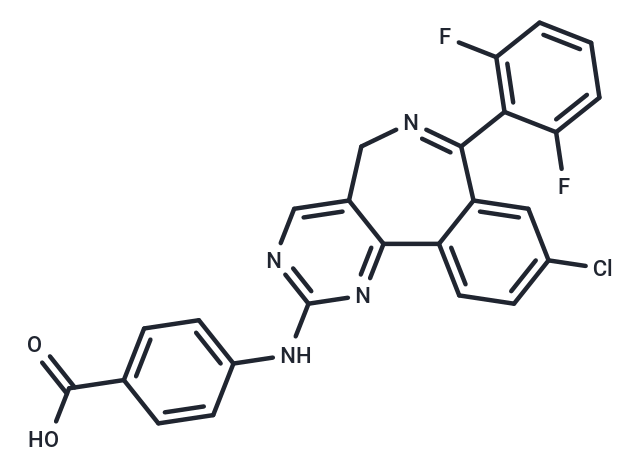Shopping Cart
- Remove All
 Your shopping cart is currently empty
Your shopping cart is currently empty

MLN8054 is a potent and selective Aurora A kinase inhibitor with an IC50 of 4 nM.

| Pack Size | Price | Availability | Quantity |
|---|---|---|---|
| 1 mg | $48 | In Stock | |
| 2 mg | $65 | In Stock | |
| 5 mg | $81 | In Stock | |
| 10 mg | $129 | In Stock | |
| 25 mg | $245 | In Stock | |
| 50 mg | $396 | In Stock | |
| 100 mg | $596 | In Stock | |
| 1 mL x 10 mM (in DMSO) | $85 | In Stock |
| Description | MLN8054 is a potent and selective Aurora A kinase inhibitor with an IC50 of 4 nM. |
| Targets&IC50 | Aurora A:4 nM |
| In vitro | MLN8054 is an ATP-competitive, reversible inhibitor of recombinant Aurora A kinase with an IC50 of 4 nM, demonstrating over 40-fold selectivity for Aurora A compared to Aurora B. [1] In vitro, MLN8054 inhibits growth across various cell lines from diverse tissues with IC50 values ranging from 0.11 μM to 1.43 μM. It selectively inhibits Aurora A over Aurora B in cultured cells, and impedes cell proliferation by inducing G2/M accumulation and spindle defects in multiple human tumor cell lines. [1] A recent study indicates that MLN8054 sensitizes androgen-resistant prostate cancer to radiation by inhibiting Aurora A kinase, leading to sustained DNA double-strand breaks. [2] |
| In vivo | In HCT-116 tumor-bearing mice, oral administration of MLN8054 at 3 mg/kg, 10 mg/kg, and 30 mg/kg once daily results in dose-dependent tumor growth inhibition (TGI: 76% and 84% for 10 mg/kg and 30 mg/kg, respectively). MLN8054 demonstrates similar antitumor activity in PC-3 tumor xenografts in nude mice. [1] In HCT-116 xenograft-bearing animals, MLN8054 induces DNA and tubulin staining of tumor tissue in nuclear and cell body areas, consistent with a senescent phenotype, by increasing senescence-associated beta-galactosidase activity. [3] |
| Kinase Assay | Enzyme Assays : Recombinant murine Aurora A and Aurora B protein are expressed in Sf9 cells and purified with GST affinity chromatography. The peptide substrate for Aurora A is conjugated with biotin (Biotin-GLRRASLG). Aurora A kinase (5 nM) is assayed in 50 mM Hepes (pH 7.5)/10 mM MgCl2/5 mM DTT/0.05% Tween 20/2 μM peptide substrate/3.3 μCi/ml [γ-33P]ATP at 2 μM by using Image FlashPlates. Aurora B kinase (2 nM) is assayed with 10 μM biotinylated peptide Biotin-TKQTARKSTGGKAPR in 50 mM Tricine (pH 8.0)/2.5 mM MgCl2/5 mM DTT/10% glycerol/2% BSA/40 μCi/ml [γ-33P]ATP at 250 μM. The conditions for all other in vitro kinase assays are available upon request. MLN8054 is run in a 226 kinase screen at a 1 μM compound concentration with an ATP concentration of 10 μM for all assays. |
| Cell Research | Human tumor cell lines are grown in 96-well cell culture dishes according to the distributor's recommendations. MLN8054, diluted in DMSO, is added to the cells in 2-fold serial dilutions to achieve final concentrations ranging from 10 mM to 0.04 mM. MLN8054 at each dilution is added in triplicate with each replicate on a separate plate. Cells treated with DMSO (n = 6 wells per plate; 0.2% final concentration) serves as the untreated control. The cells are treated with MLN8054 for 96 hours at 37 °C in a humidified cell culture chamber. Cell viability in each cell line is measured by using the Cell Proliferation ELISA, BrdU colorimetric kit according to the manufacturer's recommendation(Only for Reference) |
| Molecular Weight | 476.86 |
| Formula | C25H15ClF2N4O2 |
| Cas No. | 869363-13-3 |
| Smiles | OC(=O)c1ccc(Nc2ncc3CN=C(c4cc(Cl)ccc4-c3n2)c2c(F)cccc2F)cc1 |
| Relative Density. | 1.48 g/cm3 |
| Storage | Powder: -20°C for 3 years | In solvent: -80°C for 1 year | Shipping with blue ice. | |||||||||||||||||||||||||||||||||||
| Solubility Information | Ethanol: < 1 mg/mL (insoluble or slightly soluble) DMSO: 88 mg/mL (184.54 mM), Sonication is recommended. H2O: < 1 mg/mL (insoluble or slightly soluble) | |||||||||||||||||||||||||||||||||||
Solution Preparation Table | ||||||||||||||||||||||||||||||||||||
DMSO
| ||||||||||||||||||||||||||||||||||||

Copyright © 2015-2025 TargetMol Chemicals Inc. All Rights Reserved.